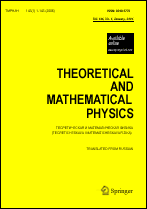|
|
Teoreticheskaya i Matematicheskaya Fizika, 1970, Volume 5, Number 2, Pages 281–292
(Mi tmf4208)
|
 |
|
 |
This article is cited in 7 scientific papers (total in 7 papers)
Schrödinger-type equation with damping for a dynamical system in a thermal bath
K. Valasek, D. N. Zubarev, A. L. Kuzemsky
Abstract:
A study is made of a dynamical system that interacts weakly with a thermal bath. The nonequilibrium statistical operator method is used to establish a Schrödinger-type equation with damping for this system. In the case of Bose statistics, a system of coupled nonlinear equations of Schrödinger and kinetic types is obtained.
Received: 10.04.1970
Citation:
K. Valasek, D. N. Zubarev, A. L. Kuzemsky, “Schrödinger-type equation with damping for a dynamical system in a thermal bath”, TMF, 5:2 (1970), 281–292; Theoret. and Math. Phys., 5:2 (1970), 1150–1158
Linking options:
https://www.mathnet.ru/eng/tmf4208 https://www.mathnet.ru/eng/tmf/v5/i2/p281
|


| Statistics & downloads: |
| Abstract page: | 500 | | Full-text PDF : | 165 | | References: | 80 | | First page: | 1 |
|




 Contact us:
Contact us: Terms of Use
Terms of Use
 Registration to the website
Registration to the website Logotypes
Logotypes









 Citation in format
Citation in format 
